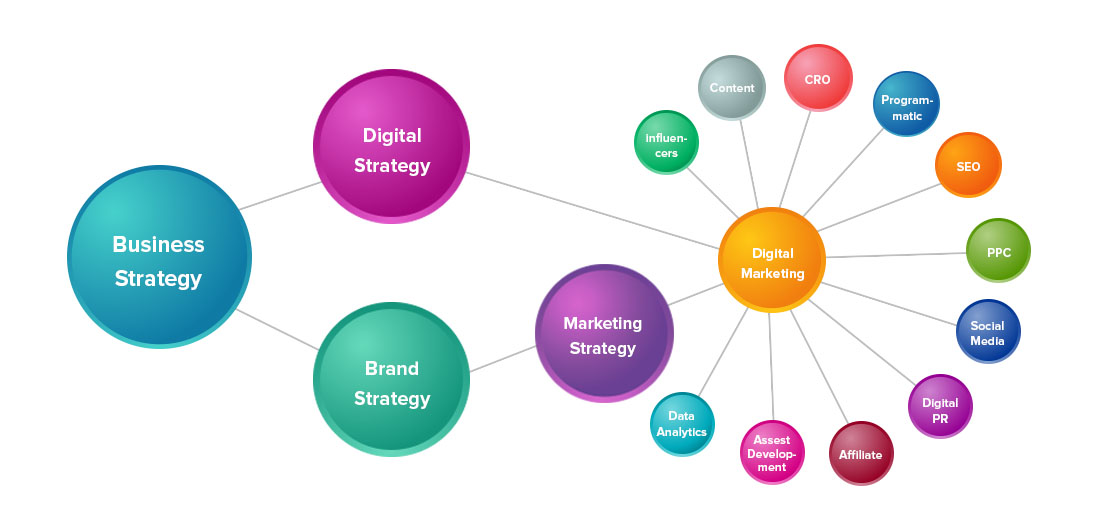
As opposed general marketing strategy, Digital Strategy concerns an organisation’s digital presence. Strategy should filter down from ‘business level’ strategy through to Marketing and Digital. Digital marketing strategy ultimately should flow from an interaction between non-marketing digital infrastructure and the general marketing department function where brand strategy, communications and media lie (see diagram below)
Digital Strategy however, can also encompass areas outside the marketing function, for example the digitization of operations, digital transformation, automation, data mining, customer relationship management systems (CRMs) security and more. Generally speaking a digital strategy will heavily focus on marketing elements such as choosing the right mix of digital mediums (Search, Social, Content, Publicity etc) and other considerations such as specific digital-led USP’s, competitive advantages, messaging strategies etc. The diagram below attempts to visualize this in a basic manner.

Before rushing into a digital-first strategy, basic fundamentals must be defined.
First a company needs to answer the following three questions:
Example: We’re James Hammon & Company, the tactical execution arm of the James Hammon Group.
Example: We help organisations take advantage of the digital world and all it has to offer by helping implement tactical sales and marketing initiatives.
Example: The rapidly changing digital environment causes problems for organisations as there’s a need to respond adequately to this dynamic environment and avoid being left behind. Customers can leverage our expertise to stay relevant and prosper in their respective marketplaces.
Business level strategy looks at the big picture. Who is your market, how big is it, what are you offering, what competitors are in the marketing and how are they positioning deeper, how much are you going to price your offering, how will you supply/distribute your offering, will you have any partnerships, what is your cost structure, staff…the list goes on. Your business strategy will therefore touch on many elements of your general marketing strategy.
At the next highest level will be your brand. It’s interesting how frequently used the work ‘brand’ is but if you ask someone for a definitive explanation, they will all offer very different answers. Contrary to popular perception, your brand is not a logo.
The first step towards defining a brand strategy, consists of performing a strategic brand analysis. This consists of a:
Once the analysis is complete, this data drives the definition of the organisation’s brand identity which consists of defining what the brand is and what it isn’t. At this time most brand managers find it useful to look at the brand from four perspectives in order to help this definition.
Then from here, brand managers will then define the following…
All of the above will feed into how the brand intends to position itself in the market. Whether the brand is interpreted as intended by your customer segments is another thing entirely. Nonetheless, positioning is important because this approach feeds directly into your Marketing and Promotional strategies. Some of the elements of the brand positioning strategy will include:
Ultimately the whole purpose of the brand strategy is to build ‘brand equity’ which can have an implied or explicit value defined at the organizational level. This it the combination of 4 main elements.
An online brand strategy should reflect elements from the traditional brand strategy but apply them to a digital environment. Things to consider will be how the brand is reflected in a digital/online environment. Often the two can differ markedly where a brand’s reputation can be perceived as being market-leading offline, but a poor digital presence can undermined this perception online.
A digital brand strategy should investigate at all the digital brand contact points, including website, apps, social media accounts, reviews, blog mentions etc. Brand monitoring technology can help here. Extending the customer experience into a digital environment should also be examined to provide service consistency.
Many digital SaaS companies use digital distribution channels and form core strategic partnerships on a digital level via integrations which can be lucrative and central to their overall business model.
Marketing is a very broad function within the organisation and can include everything from the traditional 4 P’s through to the 7 or 9 P’s. Pricing, product, people, brand management, distribution, public relations (PR), market research, segmentation, product development and more. We primarily focus on the marketing communications side of the equation and how this relates to sales.
Otherwise known as the Promotional ‘P’ of marketing, this involves formulating the messages and mediums by which the organisation’s product/service is communicated to the target market. Messages refer to what you are communicating whereas Mediums are how you are going to communicate the messages.
The two main areas we help clients implement is the Messaging and Media strategy.
A comprehensive article relating to the options available for brand relating to their media strategy can be found here.
Online or digital strategy ignores all offline mediums such as Billboards, Radio, TV, Print etc. Online strategy is ever changing and many businesses find it difficult to keep up with the dynamic nature of the industry. Once your messaging strategy is defined we will then help you choose the most appropriate digital mediums to effectively disseminate your message.
These could include…
It’s important that the correct mediums are chosen for the business. Too often than not, we find obvious choices not being used or too many mediums are being used ineffectively with no focus. Sometimes less is more, but all this depends on the goals set at the beginning and the nature of the industry.
Choosing which communication media you will use is just one half of the problem. Often what you say, and how you say it is even more critical.
How are you going to define what it is you do. What messages do your target market respond to the most? What language are you going to use. What text copy, images, colours and video will be used for your message. Each of the media above require creative content to be produced in order to disseminate your brand message to your target market.


EFFECTIVE
proven
SAFETY
simple
INTELLIGENT
INNOVATIVE
CREATIVE
protected

